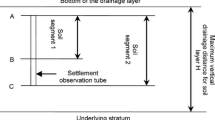Abstract
This study analyzed the effects of conventional practice of calculating consolidation settlement of soft ground by dividing the ground into one or more layers. Based on a numerical analysis of the accuracy of the calculation and the settlement behavior resulting from layering, this study found that the existing settlement calculation method always underestimates settlement, and that the smaller the number of dividing layers, the smaller the calculated settlement is observed. In addition, when the ground is divided into an infinite number of layers, the settlement is 1.2 to 50 times larger than the case when the ground is considered as a single layer, and the difference grows larger at the lower ratio of an applied pressure to an effective stress (A 0), the higher ratio of a layer thickness to a footing width (H/B), and the lower ratio of the length to width of a footing (L/B). The exact settlement can also be obtained under a single-layer condition, even when using the existing settlement calculation method, if the representative depth of calculation of the effective stress is set at a depth of approximately 10-38% from the top of the clay layer.
Similar content being viewed by others
References
Beak, S. K., Park, K., Yune, C.-Y., Chun, S.-H., and Chung, C.-K. (2005). “Estimation and prediction of the settlement behavior of test fill on back site of busan new port.” ISSMGE, ATC-7 Symposium, pp. 411–413.
Boussinesq, M. J. (1885). Application Des Potentiels, à l’Étude de l’Éqilibre et du Movvement Des Solides Elastiques, Gauthier-Villars, Paris [in French].
Brand, E. W. and Brenner, R. P. (1981). Soft clay engineering, Elsevier Science Publishing Company, pp. 485–491.
Chung, S. (1999). Consolidation characteristics of nakdong river clay, International Symposium on Soft Ground, Dong-A University.
Chung, S. G., Kim, G. J., Ryu, C. K., and Kim, M. S. (2007). “Undrained shear strength from field vane test on Busan clay.” Marine Georesources and Geotechnology, Vol. 25, No. 3, pp. 167–179, DOI: 10.1080/10641190701699350.
Chung, S. G., Ryu, C. K., Jo, K. Y., and Huh, D. Y. (2005). “Geological and geotechnical characteristics of marine clays at the Busan new port.” Marine Georesources and Geotechnology, Vol. 23, No. 3, pp. 235–251, DOI: 10.1080/10641190500225712.
Chung, S. G., Ryu, C. K., Min, S. C., Lee, J. M., Hong, Y. P., and Odgerel, E. (2012. “Geotechnical characterisation of Busan clay.” KSCE Journal of Civil Engineering, Vol. 16, No. 3, pp. 341–350, DOI: 10.1007/s12205-012-1433-8.
Das, B. M. (1984). Principles of foundation engineering, 3rd Edition, PWS Publishing Company.
Das, B. M. (2002). Principles of geotechnical engineering, Fifth Edition, Brooks/Cole.
Fatahi, B., Le, T. M., Le, M. Q., and Khabbaz, H. (2013). “Soil creep effects on ground lateral deformation and pore water pressure under embankments.” Geomechanics and Geoengineering: An International Journal, Vol. 8, No. 2, pp. 107–124, DOI: 10.1080/17486025.2012. 727037.
Fox, P. J., Pu, H. F., and Berles, J. D. (2014). “CS3 large strain consolidation model for layered soils.” Journal of Geotechnical and Geoenvironmental Engineering, Vol. 140, No. 8, pp. 1–13, DOI: 10.1061/(ASCE)GT.1943-5606.0001128.
Ho, L. and Fatahi, B. (2015). “Analytical solution for the two-dimensional plane strain consolidation of an unsaturated soil stratum subjected to time-dependent loading.” Computers and Geotechnics, Vol. 67, pp. 1–16, DOI: 10.1016/j.compgeo.2015.02.011.
Ho, L. Fatahi, B., and Khabbaz, H. (2014). “Analytical solution for onedimensional consolidation of unsaturated soils using eigenfunction expansion method.” Int. J. Numer. Anal. Meth. Geomech, Vol. 38, pp. 1058–1077, DOI: 10.1002/nag.2248.
Holtz, R. D. and Kovacs, W. D. (1981). An introduction to geotechnical engineering, Prentice-Hall, Inc.
Kim, H. M. (1988). “Assessment of tectonic and depositional environments of Naktong Delta, Korea.” Journal of Korean Earth Science Society, Vol. 9, No. 1, pp. 45–69. [in Korean]
Korean Geotechnical Society (2003). Design standard of foundations of structure, Korean Geotechnical Society. (in Korean)
Lambe, T. W. and Whitman, R. V. (1979). Soil mechanics, SIVersion, John Wiley & Sons, Inc.
Le, T. M., Fatahi, B., and Khabbaz, H. (2015). “Numerical optimisation to obtain elastic viscoplastic model parameters for soft clay.” International Journal of Plasticity Vol. 65 pp. 1–21, DOI: 10.1016/j.ijplas.2014.08.008.
Leroueil, S. (1996). “Compressibility of clays: Fundamental and practical aspects.” Journal of Geotechnical and Geoenvironmental Engineering, Vol. 122, No. 7, pp. 534–543, DOI: 10.1061/(ASCE)0733-9410(1996)122:7(534).
NAVFAC (1982). Soil mechanics, DM-7.1, pp. 223–231.
Newmark, N. M. (1935). Simplified computation of vertical pressures in elastic foundations, Engineering Experiment Station Circular No. 24, University of Illinois, Urbana.
Newmark, N. M. (1942). Influence charts for computation of stresses in elastic foundations, Engineering Experiment Station Bulletin 338, University of Illinois, Urbana.
Ninjgarav, E., Chung, S. G., Jang, W. Y., and Ryu, C. K. (2007). “Pore size distribution of Pusan clay measured by Mercury Intrusion Porosimetry.” KSCE Journal of Civil Engineering, Vol. 11, No. 3, pp. 133–139, DOI: 10.1007/BF02823892.
Tanaka, H., Mishima, O., Tanaka, M., Park, S. Z., Jeong, G. H., and Locat, J. (2001). “Characterization of Yangsan clay, Pusan, Korea.” Soils and Foundations, Vol. 41, No. 2, pp. 89–104, DOI: 10.3208/sandf.41.2_89.
Terzaghi, K., Peck, R. B., and Mesri, G. (1996). Soil mechanics in engineering practice, 3rd Edition, John Wiley & Sons, Inc. pp. 106–108.
Yune, C.-Y. and Olgun, G. (2015). “Effect of layering on total consolidation settlement of normally consolidated clay in 1D Condition.” Journal of Geotechnical and Geoenvironmental Engineering, DOI: 10.1061/(ASCE)GT.1943-5606.0001415, 06015015.
Author information
Authors and Affiliations
Corresponding author
Rights and permissions
About this article
Cite this article
Yune, CY., Olgun, C.G. Analysis of consolidation settlement of normally consolidated soil by layering under 3D conditions. KSCE J Civ Eng 20, 2280–2288 (2016). https://doi.org/10.1007/s12205-015-0171-0
Received:
Revised:
Accepted:
Published:
Issue Date:
DOI: https://doi.org/10.1007/s12205-015-0171-0




